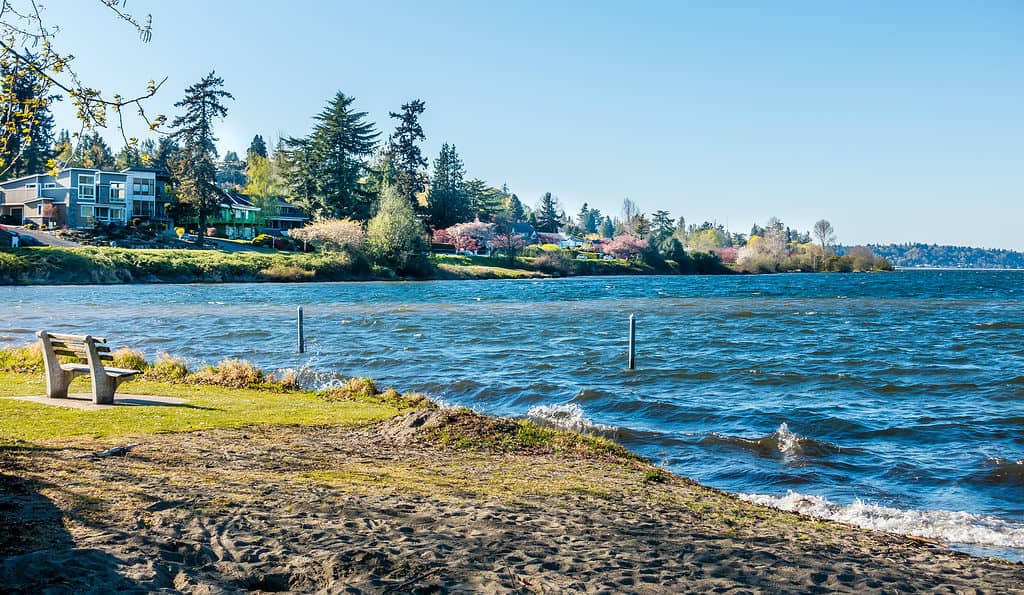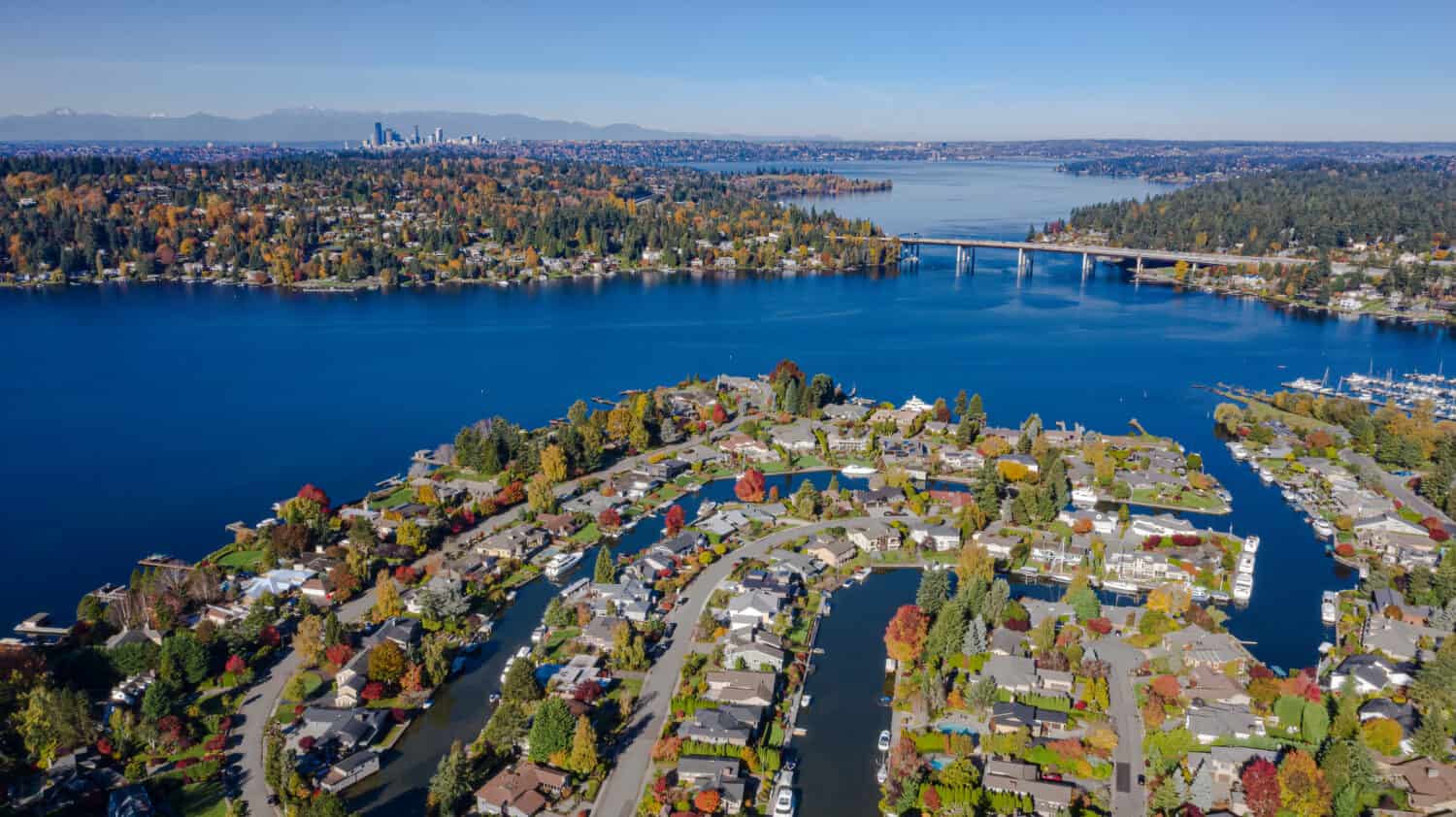The beautiful and expansive Lake Washington is situated against the glittering skyline of Seattle. Stretching over 20 miles from north to south, this massive lake carves out a space between the cities of Kirkland and Renton.
One of the most intriguing facts about Lake Washington is its variable width along its shoreline. At its widest point, the lake spans an immense 2.5 miles across. This stunning width reveals the sheer scale of this aquatic gem in Seattle‘s backyard.
Near the villages of Medina and Clyde Hill on the eastern shoreline and Hunts Point directly west, Lake Washington reaches its maximum width of approximately 2.5 miles at its widest. Standing on either shore gazing east or west, the opposite side is visible on the horizon. It’s a spectacular sight, emphasizing the vast expanse of this natural wonder.
But the lake has not always spanned this distance. Tracing back thousands of years reveals the fascinating forces that formed the lake and its changing width.

Lake Washington was formed during the ice age.
©GeorgeColePhoto/Shutterstock.com
Formed During the Ice Age
The foundation of Lake Washington began at the end of the last Ice Age, over 15,000 years ago. During this time, the Puget Lobe of the massive Cordilleran Ice Sheet crept south over Western Washington. This glacial lobe gouged out a long depression through the Seattle region as it advanced and retreated. As the ice melted, it left behind a large basin filled with glacial meltwater — the beginnings of Lake Washington.
Over many millennia, the glacier-carved lake was influenced by other natural forces that gradually widened it. The Seattle Fault zone running west of the lake caused tectonic shifts, which tilted the lake’s basin southward. This tilting made the southern portion of the lake significantly wider than the northern end.
Ongoing sediment erosion and deposition over thousands of years also widened the lake. Small streams and rivers surrounding the lake eroded soil and rock, depositing the sediment into the lake basin. This continual process steadily widened the lake through time. The modern lake is a product of these powerful geological forces that shaped the land over thousands of years.
Variable Width
Unlike some other lakes with a nearly consistent width, Lake Washington’s varying span is one of its defining traits. On its northern tip near Kirkland, the lake is just 2 miles wide — less than half its maximum width. This section has a relatively narrow basin hemmed in by steep hillsides on both shores.
Open parks like Madison Park on the east side and Seward Park stretching west provide excellent vantage points to appreciate the expanding width.
Continuing south to Mercer Island, the lake begins to showcase its full scale. The lake crests 4 miles wide, nearly double the narrow northern reaches. Looking due east or west from shore, the distant opposite side is faintly visible across the watery expanse.
Reaching the midpoint near Medina and Clyde Hill, Lake Washington finally attains its maximum 2.5-mile width. Gazing east or west, the distant shore sits just above the horizon. This area best displays the lake’s tremendous size and scale.
This variability makes Lake Washington unique among its peers. Rather than a static width, boaters can experience the lake expanding before their eyes as they cruise south. The changing width reflects the ancient forces that carved out this natural wonder of the Pacific Northwest.

The sockeye salmon is one of the cold water species you can find in Lake Washington.
©Sergey Uryadnikov/Shutterstock.com
Providing Diverse Aquatic Habitats
In addition to beauty, Lake Washington’s size provides crucial aquatic habitats. Cold water species like trout and sockeye salmon thrive in the deepest open waters reaching over 200 feet. These salmon migrate yearly from Puget Sound into the lake through the Ballard Locks. They travel 20 miles to spawn in tributaries, including the Cedar River.
The lake’s shallow edges, marshy wetlands, and smaller tributaries like the Sammamish River foster warmer, calmer environments. Here bass, yellow perch, and painted turtles make their homes. Migrating waterfowl like grebes and cormorants frequent these areas to dive for fish and rest.
Healthy populations of warm and cold water creatures make Lake Washington their home, thanks to the assortment of aquatic habitats.
Recreational Paradise
The enormous width also makes Lake Washington a popular recreation destination. On sunny days, the open water swells with boats of all kinds. Fishing skiffs work the deeper waters while waterskiers, wakeboarders, and parasailers carve through the surf. Sleek sailing catamarans glide across the surface, their billowing sails full of wind.
Kayakers and stand-up paddleboarders stick to calmer sections and meander along the shoreline. Seward Park’s 2.4-mile trail is dotted on the eastern shores with swimmers and sunbathers during summer. Similar scenes unfold at Seattle’s Madison Park and Kirkland’s Marina Park. With numerous access points around the lake, the wide waters welcome recreationists of all kinds.
Some intrepid open-water swimmers also take on the challenge of crossing the 2.5-mile span. This would take over two hours of determined effort for an average swimmer. Those who complete the crossing describe an incredible feeling — watching Seattle’s skyline recede behind them as they swim towards the distant opposite shore. It highlights the vastness of their liquid surroundings.
Time to Swim Across
Lake Washington averages about 2.5 miles wide, and an average swimmer swims at a speed of 2 miles per hour; it would take approximately 1.25 hours (or 1 hour and 15 minutes) for the swimmer to swim across the lake at its average width.
Since Lake Washington averages 2.5 miles wide, and the average swimmer’s speed is 2 miles per hour, dividing the width by the speed shows it would take around 1.25 hours to swim across.

Lake Washington is a relaxing spot to be.
©Danita Delimont/Shutterstock.com
Peaceful and Relaxing
From a perch at Seward Park or Madison Park, the uninterrupted sightline across 2.5 miles has an instantly calming effect. Watching the dancing sparkles of sunlight on the water, boats lazily drifting by, and birds gliding over the surface instills a sense of peace.
There is something mesmerizing about an unbroken view across such an immense stretch of water. It seems to dissolve stress and anxiety, leaving only tranquility and quiet contentment. The ebb and flow of the lake’s tiny waves gently wash away worries and troubles. Everything slows down, inviting you to sink into the moment.
Comparing Iconic Lakes
There are many iconic lakes in the United States, each with unique features and attractions. Lake Washington, Lake Tahoe, Crater Lake, and the Lake of the Ozarks are just a few examples of these stunning bodies of water.
Lake Washington is a large lake located in the state of Washington. It is known for its beautiful scenery and recreational opportunities. Lake Tahoe, located in the Sierra Nevada mountains on the border of California and Nevada, is known for its clear blue water and stunning mountain views. It has a maximum width of approximately 12 miles.
Crater Lake, located in Oregon, is a volcanic crater lake known for its deep blue color and water clarity. It has a maximum width of approximately 5 miles. The Lake of the Ozarks, located in Missouri, is a man-made lake with a surface area of 1 mile. It is a popular destination for boating and fishing.
Each of these lakes has its unique charm and appeal. Whether you’re looking for stunning scenery, recreational opportunities, or a peaceful place to relax, these iconic lakes will surely impress.
| Lake | Width in Miles (approximate) |
|---|---|
| Lake Washington | 2.5 |
| Lake Tahoe | 12 |
| Crater Lake | 5 |
| Lake of the Ozarks | 1 |
Native History Along the Shores
For thousands of years before European settlement, Pacific Northwest native peoples populated the shores of Lake Washington. The lake was a vital resource for tribes, including the Duwamish, Muckleshoot, Snoqualmie, and Suquamish peoples. Their ancestors bore witness to the formation of the lake from its origins as a glacier-carved basin into the lake known today.
Native peoples traversed the lake by canoe traveling to settlements on the opposite shore. They fished the bountiful waters for trout, salmon, and other species. The lake also provided fresh water and transportation routes not just for tribes along its banks but for trade further east via portage to Lake Sammamish.
Even the name “Lake Washington” has native roots. It comes from Lake Sahalee nyah, meaning “lake belonging to the people of Sahalee” in Coast Salish dialects. Sahalee refers to a group of villages once located on the lake’s southeastern shores.
Wrapping It Up
Lake Washington fully lives up to its billing as the widest lake in Washington. Formed by glacial forces and expanded through tectonic shifts and ongoing erosion, the 2.5 width is visually stunning from shore. The lake supports abundant wildlife thanks to varied aquatic habitats across its vast expanse. It also offers some of the best freshwater recreation options in the Seattle metro area.
Those wanting to experience the full scale of Lake Washington should head to any shoreline parks near Medina, Clyde Hill, or Hunts Point. The unbroken sightline to the opposite shore underscores the immensity of the Pacific Northwest’s aqueous jewel. Looking out over the watery expanse, you gain a whole new appreciation for the natural forces that sculpted the land into what we marvel at today.
The photo featured at the top of this post is © GeorgeColePhoto/Shutterstock.com
Thank you for reading! Have some feedback for us? Contact the AZ Animals editorial team.






